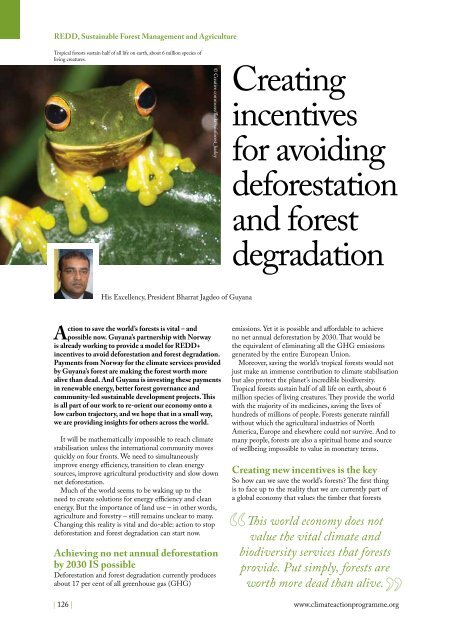Climate Action 2010-2011
Create successful ePaper yourself
Turn your PDF publications into a flip-book with our unique Google optimized e-Paper software.
Redd, Sustainable Forest Management and Agriculture<br />
Tropical forests sustain half of all life on earth, about 6 million species of<br />
living creatures.<br />
© Creative commons/flickr/rainforest_harley<br />
Creating<br />
incentives<br />
for avoiding<br />
deforestation<br />
and forest<br />
degradation<br />
His Excellency, President Bharrat Jagdeo of Guyana<br />
<strong>Action</strong> to save the world’s forests is vital – and<br />
possible now. Guyana’s partnership with Norway<br />
is already working to provide a model for Redd+<br />
incentives to avoid deforestation and forest degradation.<br />
Payments from Norway for the climate services provided<br />
by Guyana’s forest are making the forest worth more<br />
alive than dead. And Guyana is investing these payments<br />
in renewable energy, better forest governance and<br />
community-led sustainable development projects. This<br />
is all part of our work to re-orient our economy onto a<br />
low carbon trajectory, and we hope that in a small way,<br />
we are providing insights for others across the world.<br />
It will be mathematically impossible to reach climate<br />
stabilisation unless the international community moves<br />
quickly on four fronts. We need to simultaneously<br />
improve energy efficiency, transition to clean energy<br />
sources, improve agricultural productivity and slow down<br />
net deforestation.<br />
Much of the world seems to be waking up to the<br />
need to create solutions for energy efficiency and clean<br />
energy. But the importance of land use – in other words,<br />
agriculture and forestry – still remains unclear to many.<br />
Changing this reality is vital and do-able: action to stop<br />
deforestation and forest degradation can start now.<br />
Achieving no net annual deforestation<br />
by 2030 IS possible<br />
Deforestation and forest degradation currently produces<br />
about 17 per cent of all greenhouse gas (GHG)<br />
| 126 |<br />
emissions. Yet it is possible and affordable to achieve<br />
no net annual deforestation by 2030. That would be<br />
the equivalent of eliminating all the GHG emissions<br />
generated by the entire European Union.<br />
Moreover, saving the world’s tropical forests would not<br />
just make an immense contribution to climate stabilisation<br />
but also protect the planet’s incredible biodiversity.<br />
Tropical forests sustain half of all life on earth, about 6<br />
million species of living creatures. They provide the world<br />
with the majority of its medicines, saving the lives of<br />
hundreds of millions of people. Forests generate rainfall<br />
without which the agricultural industries of North<br />
America, Europe and elsewhere could not survive. And to<br />
many people, forests are also a spiritual home and source<br />
of wellbeing impossible to value in monetary terms.<br />
Creating new incentives is the key<br />
So how can we save the world’s forests? The first thing<br />
is to face up to the reality that we are currently part of<br />
a global economy that values the timber that forests<br />
This world economy does not<br />
value the vital climate and<br />
biodiversity services that forests<br />
provide. Put simply, forests are<br />
worth more dead than alive.<br />
www.climateactionprogramme.org












